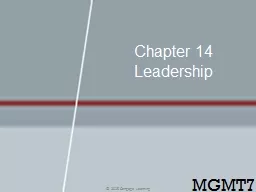

Leadership 2015 Cengage Learning MGMT7 2015 Cengage Learning 141 explain what leadership is 142 describe who leaders are and what effective leaders do 143 explain Fiedlers contingency theory ID: 237158
Download Presentation The PPT/PDF document "Chapter 14" is the property of its rightful owner. Permission is granted to download and print the materials on this web site for personal, non-commercial use only, and to display it on your personal computer provided you do not modify the materials and that you retain all copyright notices contained in the materials. By downloading content from our website, you accept the terms of this agreement.
Slide1
Chapter 14 Leadership
© 2015 Cengage Learning
MGMT7Slide2
© 2015 Cengage Learning
14-1 explain what leadership is
14-2
describe who leaders are and what effective leaders do
14-3
explain Fiedler’s contingency theory
14-4
describe how path-goal theory works
14-5
explain the normative decision theory
14-6
explain how visionary leadership (i.e., charismatic or transformational leadership) helps leaders achieve strategic leadershipSlide3
Leaders vs. Managers
© 2015 Cengage Learning
Doing the right thing
“What should we be doing?”
Vision, mission, goals, objectives
Challenge the status quo
Long-term view
Expand people’s options and choicesInspire and motivate people to find their own solutionsConcerned with ends, what gets done
Doing things right“How can we do what we’re already doing better?” Productivity and efficiencyPreservers of status quoShort-term viewLimit others’ choicesSole problems so that others can do their workMore concerned with means, how things get done
14-1Slide4
Leadership Traits
Trait theoryeffective leaders possess a similar set of traits or characteristics
Leaders are different from followers in:
drive
desire to lead
honest/integrity
self-confidence
emotional stabilitycognitive abilityknowledge of the business
© 2015 Cengage Learning14-2Slide5
Leadership Behaviors
Initiating structureConsideration
©
2015
Cengage Learning
14-2Slide6
Blake/Mouton Leadership Grid
14-2
©
2015
Cengage LearningSlide7
Fiedler’s Contingency Theory
In order to maximize work group performance, leaders must be matched to the right leadership situation.Leaders are effective when the work group they lead performs well.
Leaders are generally unable to change their leadership styles, and they will be more effective when their styles are matched to the proper situation.
The favorableness of a situation permits the leader to influence the behavior of group members.
©
2015
Cengage Learning
14-3Slide8
Least Preferred Coworker
Leadership style = the way that leaders generally behave toward their followers. Leadership styles are tied to leaders’ underlying needs and personalities.
Relationship-oriented
Task-oriented
©
2015
Cengage Learning
14-3Slide9
Situational Favorableness
© 2015 Cengage Learning
The degree to which a particular situation either permits or denies a leader the chance to influence the behavior of group members.
Leader-member relations
Task structure
Position power
14-3Slide10
Situational Favorableness
© 2015 Cengage Learning
14-3Slide11
Matching Leadership Styles to Situations
14-3
©
2015
Cengage LearningSlide12
Leaders and Situations
Fiedler assumes leaders to be incapable of changing their leadership styles.The key − matching leaders to situations…
…or teaching leaders how to change situational favorableness
©
2015
Cengage Learning
14-3Slide13
Path-Goal Theory
Leaders can increase subordinate satisfaction and performance by clarifying and clearing the paths to goals and by increasing the number and kinds of rewards available for goal attainment.
©
2015
Cengage Learning
14-4Slide14
Path-Goal Theory
14-4
©
2015
Cengage LearningSlide15
Leadership Styles
DirectiveSupportiveParticipativeAchievement-oriented
©
2015
Cengage Learning
14-4Slide16
Subordinate Contingencies
Perceived abilityExperienceLocus of controlinternals vs. externals
©
2015
Cengage Learning
14-4Slide17
Environmental Contingencies
Task structureFormal authority systemPrimary work group
©
2015
Cengage Learning
14-4Slide18
Path-Goal Theory: When to Use Directive, Supportive, Participative, or Achievement-Oriented Leadership
14-4
©
2015
Cengage LearningSlide19
Normative Decision Theory
Helps leaders decide how much employee participation (from none to letting employees make the entire decision) should be used when making decisions.©
2015
Cengage Learning
14-5Slide20
Normative Theory, Decisions Styles, and Levels of Employee Participation
14-5
©
2015
Cengage LearningSlide21
Normative Theory Decision Rules
14-5
©
2015
Cengage LearningSlide22
Normative Decision Theory Tree for Determining the Level of Participation in Decision Making
14-5
©
2015
Cengage LearningSlide23
Visionary Leadership
Creates a positive image of the future that motivates organizational members and provides direction for future planning and goal setting.©
2015
Cengage Learning
14-6Slide24
Charismatic Leadership
The behavioral tendencies and personal characteristics of leaders that create an exceptionally strong relationship with followers.
Articulate a clear vision for the future that is based on strongly held values or morals
Model those values by acting in a way consistent with the vision
Communicate high performance expectations to followers
Display confidence in followers’ abilities to achieve the vision
©
2015 Cengage Learning
14-6Slide25
Ethical and Unethical Charismatics
14-6
©
2015
Cengage LearningSlide26
Transformational Leadership
Generates awareness and acceptance of a group’s purpose and mission and gets employees to see beyond their own needs and self interests for the good of the group. ©
2015
Cengage Learning
14-6Slide27
Components of Transformational Leadership
Charismatic leadership or idealized influenceInspirational motivation
Intellectual stimulation
Individualized consideration
©
2015
Cengage Learning
14-6Slide28
Transactional Leadership
Based on an exchange process in which followers are rewarded for good performance and punished for poor performance. © 2015
Cengage Learning
14-6Slide29
Camp Bow Wow
1. Does Camp Bow Wow CEO Heidi Ganahl possess qualities associated with contemporary leadership? 2. In what way is Heidi Ganahl’s leadership charismatic and visionary? Give examples.
3. Where does Heidi Ganahl’s leadership fall on the Leader-ship Grid discussed in the chapter? Explain.
©
2015
Cengage Learning